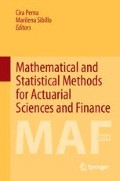Abstract
Longevity risk plays a central role in the insurance company management since only careful assumptions about future evolution of mortality phenomenon allows the company to correctly front its future obligations. According to Solvency II longevity risk represents a sub-module of the underwriting risk module in the regulatory standard formula. In this paper we examine the adequacy of the shock’s structure suggested by the standard formula studying its impact on the solvency capital requirements and liabilities at different ages. In particular, we propose an alternative to the regulatory standard model represented by a flexible internal model. The innovative approach hinges on a stochastic volatility model and a so-called coherent risk measure as the expected shortfall. An empirical analysis is provided.
Access this chapter
Tax calculation will be finalised at checkout
Purchases are for personal use only
References
Borger, M.: Deterministic shock vs. stochastic value-at-risk: an analysis of the solvency II standard model approach to longevity risk. Blätter DGVFM 31, 225–259 (2010)
Bouma, S.: Risk Management in the Insurance Industry and Solvency II. Capgemini Compliance and Risk Management Centre of Excellence (2006)
CEIOPS, QIS 5, Technical Specifications (2010). https://eiopa.europa.eu/consultations/qis/quantitative-impact-study-5/technical-specifications/index.html
Cox, J.C., Ingersoll, J.E., Ross, S.: A theory of the term structure of interest rates. Econometrica 53(2), 385–407 (1985)
IAIS, International Association of Insurance Supervisors: global reinsurance. Market Report (2008)
Olivieri, A., Pitacco, E.: Solvency requirements for life annuity: some comparisons. G. Ist. Ital. Attuari LXXI(1–2), 59–82 (2008)
Schobel, R., Zhu, J.W.: Stochastic volatility with an Ornstein-Uhlenbeck process: an extension. Eur. Finance Rev. 3, 23–46 (1998)
Stein, J., Stein, E., Price, S.: Distributions with stochastic volatility: an analytic approach. Rev. Financ. Stud. 4, 727–752 (1991)
Author information
Authors and Affiliations
Corresponding author
Editor information
Editors and Affiliations
Rights and permissions
Copyright information
© 2014 Springer International Publishing Switzerland
About this chapter
Cite this chapter
Coppola, M., D’Amato, V. (2014). The Solvency Capital Requirement Management for an Insurance Company. In: Perna, C., Sibillo, M. (eds) Mathematical and Statistical Methods for Actuarial Sciences and Finance. Springer, Cham. https://doi.org/10.1007/978-3-319-05014-0_15
Download citation
DOI: https://doi.org/10.1007/978-3-319-05014-0_15
Publisher Name: Springer, Cham
Print ISBN: 978-3-319-05013-3
Online ISBN: 978-3-319-05014-0
eBook Packages: Mathematics and StatisticsMathematics and Statistics (R0)

